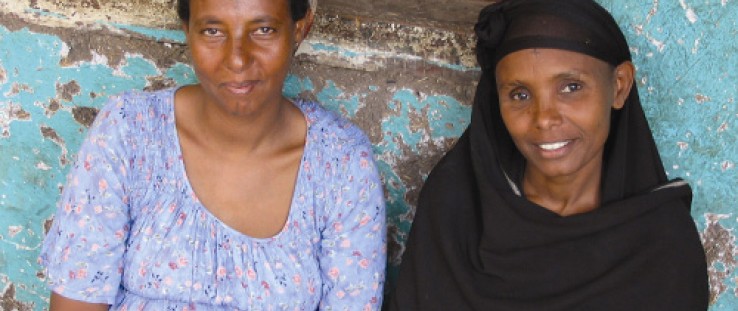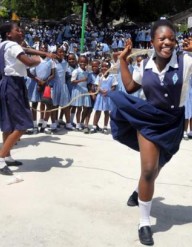 Pathfinder-Ethiopia
Pathfinder-Ethiopia
 Pathfinder-Ethiopia
Pathfinder-Ethiopia
At age 12, Loko, whose last name is withheld for privacy reasons, was forced to marry a man 50 years her senior. As with many child marriages in her home country of Ethiopia, it was a family member who made the decision that derailed her childhood. The 10th of 11 children, she was sold off by her older brother after their father died. Marriage brought a destitute life—her husband was too old to work, and they often went hungry.
Two years later, she became pregnant. After a difficult delivery, she lost her child and ended up with a fistula, a painful childbirth-related injury that left her incontinent—and which could have been prevented with more accessible medical care such as a C-section.
After seven years, Loko's life took a sudden turn. With USAID assistance, she was sent to a distant hospital to undergo surgery to repair the fistula. Fourteen days later, she walked out of the hospital, healthy again.
It was, she said, "more than I had ever dreamt about [and] made me feel again as a human being equal to the others."
Determined not to let others suffer as she had, Loko became a community advocate against child marriage. "I promised that I will continue to work hard on these issues throughout my life, with full commitment to act as a model," she said.
In recognition that women like Loko are the most powerful advocates for women's rights in their communities, USAID is supporting other efforts to help women use their voices and stories to help others.
One such program, "Through Our Eyes," helps community members communicate their stories through video and raise issues that are often not discussed. The project has worked with communities in Liberia, Southern Sudan, Rwanda, Uganda, and Thailand to produce 40 short videos.
In one video, a man lures a young girl into his house under the premise of buying the fruit she is selling. This film and others are used to illustrate topics that are all too common around the world, including rape, child marriage, and domestic violence.
In Liberia, a video made in collaboration with the Fistula Rehabilitation Center on the link between early marriage and fistula was shown to 629 women and 462 men, successfully educating them about the risks involved and persuading many of the women to seek care at local health-care facilities.
The Child Bride Pandemic
Worldwide, there are approximately 51 million child brides—those married under the age of 18—and over the next 10 years, an estimated 100 million girls, or roughly a third of the population of the United States, will be married before the age of 18. Many factors, including poverty, poor education, and traditional practices, contribute to the enduring practice of child marriage. In addition, girls below the age of 15 are five times more likely to die in childbirth than women in their 20s. They are also predisposed to sustain injuries, such as fistulas, which plague approximately 2 million women worldwide. These injuries could be prevented with timely access to emergency obstetric care.
The USAID-produced videos have been shown at 440 community "playbacks" around the world. After the video, trained facilitators guide public discussions with the audience. The goal is for the videos not only to build awareness, but also to transform women's roles in the process.
According to Liberian video trainer Albert Pyne, "usually in our setting, in the Liberian setting, Liberian women don't really speak in public, especially when the men are around. Whenever they gather, they don't speak openly. But if you take the video to the community and do a playback, the women see themselves sometimes in the picture and they don't care who is around. They will speak their mind . . . and you will see their emotion."
As a result, "it empowers our sisters, our mothers, to speak for themselves, to express their feeling about the level of violence against them, and the way out . . . . The video can mobilize the community for itself," Pyne said.
However, community involvement does not stop there.
Acknowledging that the deeper roots of the practice have to be addressed, USAID has helped fund an additional program in Ethiopia that engages religious leaders, teachers, and the public in forums to discuss the harmful effects of early marriage.
Opening up the Floor
At advocacy sessions in the Tigrai and Amhara regions in 2005, representatives from the country's main religious bodies—Muslims, Orthodox Christians, Catholics, and Evangelists—agreed to resolutions condemning early marriage and vowing to teach their followers about the dangers of such practices. At an advocacy session, one Muslim leader explained the importance of these measures: "When girls are married at a young age, they get hurt because their bodies have not matured yet. We, as religious leaders, should be serious about this."
These efforts have begun to pay off. According to USAID partner Pathfinder, the national rate of child marriage in Ethiopia fell from 33.1 percent to 21.4 percent between 1998 and 2008. In the Amhara region, where the practice was particularly entrenched, the rate fell from 61.8 percent to 44.8 percent over the 10 years of the USAID-Pathfinder intervention.Yeshi Alem, from the Amhara region, is another example of the new attitude that is beginning to spread in Ethiopia. With five children of her own, including four girls, she has helped prevent more than 300 early marriages in her community, working through its early marriage committee.
"I teach from experience. I know the hardships of raising many children," Alem said. "My husband now sees the benefits of what I started eight years ago even though he wasn't convinced of it then."










Comment
Make a general inquiry or suggest an improvement.